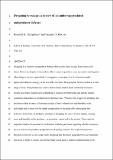Files in this item
Dropping to escape : a review of an under-appreciated antipredator defence
Item metadata
| dc.contributor.author | Humphreys, Rosalind K. | |
| dc.contributor.author | Ruxton, Graeme D. | |
| dc.date.accessioned | 2019-10-08T23:36:51Z | |
| dc.date.available | 2019-10-08T23:36:51Z | |
| dc.date.issued | 2019-04 | |
| dc.identifier | 256155897 | |
| dc.identifier | 92393366-0168-4de7-9688-d2ece5f0e267 | |
| dc.identifier | 85054597349 | |
| dc.identifier | 000461070800012 | |
| dc.identifier.citation | Humphreys , R K & Ruxton , G D 2019 , ' Dropping to escape : a review of an under-appreciated antipredator defence ' , Biological Reviews , vol. 94 , no. 2 , pp. 575-589 . https://doi.org/10.1111/brv.12466 | en |
| dc.identifier.issn | 1464-7931 | |
| dc.identifier.uri | https://hdl.handle.net/10023/18628 | |
| dc.description | Authors thank the Perry Foundation and the University of St Andrews for funding. | en |
| dc.description.abstract | Dropping is a common antipredator defence that enables rapid escape from a perceived threat. However, despite its immediate effectiveness in predator–prey encounters (and against other dangers such as a parasitoid or an aggressive conspecific), it remains an under‐appreciated defence strategy in the scientific literature. Dropping has been recorded in a wide range of taxa, from primates to lizards, but has been studied most commonly in insects. Insects have been found to utilise dropping in response to both biotic and abiotic stimuli, sometimes dependent on mechanical or chemical cues. Whatever the trigger for dropping, the decision to drop by prey will present a range of inter‐related costs and benefits to the individual and so there will be subtle complexities in the trade‐offs surrounding this defensive behaviour. In predatory encounters, dropping by prey will also impose varying costs and benefits on the predator – or predators – involved in the system. There may be important trade‐offs involved in the decision made by predators regarding whether to pursue prey or not, but the predator perspective on dropping has been less explored at present. Beyond its function as an escape tactic, dropping has also been suggested to be an important precursor to flight in insects and further study could greatly improve understanding of its evolutionary importance. Dropping in insects could also prove of significant practical importance if an improved understanding can be applied to integrated pest‐management strategies. Currently the non‐consumptive effects of predators on their prey are under‐appreciated in biological control and it may be that the dropping behaviour of many pest species could be exploited via management practices to improve crop protection. Overall, this review aims to provide a comprehensive synthesis of the current literature on dropping and to raise awareness of this fascinating and widespread behaviour. It also seeks to offer some novel hypotheses and highlight key avenues for future research. | |
| dc.format.extent | 613377 | |
| dc.language.iso | eng | |
| dc.relation.ispartof | Biological Reviews | en |
| dc.subject | Dropping | en |
| dc.subject | Antipredator defence | en |
| dc.subject | Predator-prey interaction | en |
| dc.subject | Behavioural ecology | en |
| dc.subject | Evolution | en |
| dc.subject | Biological control | en |
| dc.subject | Integrated pest-management | en |
| dc.subject | QH301 Biology | en |
| dc.subject.lcc | QH301 | en |
| dc.title | Dropping to escape : a review of an under-appreciated antipredator defence | en |
| dc.type | Journal item | en |
| dc.contributor.institution | University of St Andrews. School of Biology | en |
| dc.contributor.institution | University of St Andrews. Centre for Biological Diversity | en |
| dc.identifier.doi | https://doi.org/10.1111/brv.12466 | |
| dc.description.status | Peer reviewed | en |
| dc.date.embargoedUntil | 2019-10-09 |
This item appears in the following Collection(s)
Items in the St Andrews Research Repository are protected by copyright, with all rights reserved, unless otherwise indicated.

